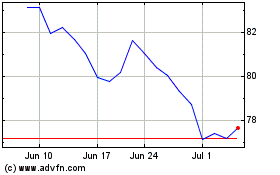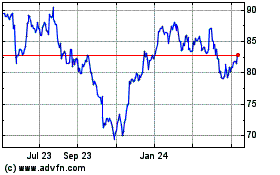Medtronic Receives FDA Approval and Launches Two New Cardiac Resynchronization Therapy Quadripolar Leads
December 11 2014 - 9:00AM


Additional Attain
Performa® Quadripolar Leads Provide Physicians with More Options to
Optimize Delivery of Proven Heart Failure Treatment
MINNEAPOLIS - Dec. 11, 2014 - Medtronic, Inc. (NYSE: MDT) today
announced the U.S. Food and Drug Administration (FDA) approval and
commercial launch of two additional Attain Performa® left
ventricular (LV) quadripolar leads, which can be paired with the
Medtronic Viva® Quad XT and Viva® Quad S cardiac resynchronization
therapy defibrillators (CRT-D) to treat patients with heart
failure. The newest additions to the Attain Performa lead
portfolio, the S-shape and Straight leads, are designed to
accommodate patients' varying vessel sizes and curvatures to
enhance successful lead placement. Quadripolar leads (leads with
four electrodes) help physicians optimize cardiac resynchronization
therapy, which uses an implantable device to improve the pumping
efficiency of the heart.
FDA approval for the additional quadripolar leads
follows the August 2014 approval of the Attain Performa Model 4298
Dual Cant quadripolar lead. All three leads were studied in the
multicenter Attain Performa Quadripolar Lead Clinical Study,
involving more than 1,200 patients. Results featured at the 2014
American Heart Association Scientific Session demonstrate an
excellent implant success rate (97.6 percent), and show that CRT
with the Attain Performa family of LV quadripolar leads is
associated with a low complication rate, and low, stable pacing
capture thresholds (PCTs) through six months for all pacing
polarities.i
"While optimal lead positioning has been shown to
improve CRT response rates, every patient is different, making lead
placement and stability a common challenge that can result in
nonresponse to therapy," said George H. Crossley, M.D., F.A.C.C.,
F.H.R.S., associate professor, Vanderbilt Heart and Vascular
Institute in Nashville, Tenn. "Having access to a range of lead
shapes that work with one CRT-D system gives physicians the ability
to help our heart failure patients, even if their cardiac anatomy
is challenging."
The three Attain Performa lead shapes -Dual Cant
Model 4298, Straight Model 4398 and S-Shape Model 4598 -were
designed to accommodate various anatomies without compromising lead
handling or stability. With 16 pacing configurations and shorter
spacing between the two center electrodes, these quadripolar leads
have been shown to reduce the incidence of phrenic nerve
stimulation (PNS), a potential issue associated with CRT therapy
that results in muscle twitching, hiccups or shortness of
breath.ii Attain
Performa leads also include steroid elution on all four electrodes
for lower chronic pacing thresholds, which contribute to greater
device longevity and reduce the likelihood of PNS.iii
"With the two new shapes, the Attain Performa
quadripolar lead portfolio gives physicians more options than any
other CRT-D system available in the United States," said David
Steinhaus, M.D., vice president and general manager, Heart Failure,
and medical director for the Cardiac Rhythm and Heart Failure
Business at Medtronic. "We are committed to driving advancements in
CRT, and designed these leads to give physicians tools to customize
treatment for their patients."
All three Attain Performa leads are compatible
with the company's newest portfolio of CRT devices, the Viva Quad
XT and Viva Quad S CRT-D systems. The Viva Quad XT CRT-D features
the Medtronic-exclusive AdaptivCRT® algorithm, which significantly
improves heart failure patients' response rate to therapy by
preserving normal heart rhythms and automatically adapting to
patient needs, creating a customized therapy for each patient.
AdaptivCRT is the only algorithm demonstrated to improve heart
failure patients' response to the therapyiv (as compared
to conventional biventricular therapy) and reduce the risk of
atrial fibrillation, or AFv.
The system also includes VectorExpress(TM)
technology, an automated in-office test that reduces lead
programming time to two minutes,vi and reveals
clinically actionable information to help physicians select optimal
pacing configurations for each patient.
About the Attain Performa
Quadripolar Lead Clinical Study
The Attain Performa Quadripolar Lead Clinical Study is a global
trial that evaluated the safety and effectiveness of the Attain
Performa leads. The study demonstrated a 97.6 percent implant
success rate and the PNS complication-free rate was 99.7 percent.
Steroid on all four electrodes resulted in low, stable PCTs through
six months for all pacing polarities. The study enrolled 1,201
patients indicated for a CRT-D from approximately 130 centers
across the world. All implanted patients were followed at one,
three, six and every subsequent six months post-implant.
In collaboration with leading clinicians,
researchers and scientists worldwide, Medtronic offers the broadest
range of innovative medical technology for the interventional and
surgical treatment of cardiovascular disease and cardiac
arrhythmias. The company strives to offer products and services
that deliver clinical and economic value to healthcare consumers
and providers around the world.
ABOUT MEDTRONIC
Medtronic, Inc. (www.medtronic.com), headquartered in Minneapolis,
is the global leader in medical technology - alleviating pain,
restoring health and extending life for millions of people around
the world.
Any forward-looking statements
are subject to risks and uncertainties such as those described in
Medtronic's periodic reports on file with the Securities and
Exchange Commission. Actual results may differ materially from
anticipated results.
- end -
i Crossley et
al. A Novel Quadripolar Lead with a Narrow-Spaced Bipole Allows for
Effective Left Ventricular Pacing While Avoiding Phrenic Nerve
Stimulation - Attain® Performa(TM) LV Lead Study Primary Results.
American Heart Association Scientific Sessions. 2014
ii Biffi et al.
Effort of Bipolar Electrode Spacing on Phrenic Nerve Stimulation
and Left Ventricular Pacing Thresholds: An Acute Canine Study.
Circulation Arrhythmia and Electrophysiology. 2012.
iii Lunati MG,
Gasparini M, Landolina M, et al. Long-Term Effect of Steroid
Elution on the Electrical Performance of Coronary Sinus Leads for
Cardiac Resynchronization Therapy. Presented at HRS 2012
(AB10-05).
iv Birnie D,
Lemke B, Aonuma K, et al. Clinical outcomes with synchronized left
ventricular pacing: Analysis of the adaptive CRT trial. Heart
Rhythm. September 2013;10(9):1368-1374.
v Martin D, et
al. Can Adaptive Cardiac Resynchronization Therapy Reduce Atrial
Fibrillation Risk? Circulation. 2013;128(22S):A17740.
vi Demmer, W.
VectorExpress Performance Results. Medtronic data on file. January
2013.
Contacts:
Tracy McNulty
Public Relations
+1-763-526-2492
Jeff Warren
Investor Relations
+1-763-505-2696
This
announcement is distributed by NASDAQ OMX Corporate Solutions on
behalf of NASDAQ OMX Corporate Solutions clients.
The issuer of this announcement warrants that they are solely
responsible for the content, accuracy and originality of the
information contained therein.
Source: Medtronic, Inc. via Globenewswire
HUG#1879024
Medtronic (NYSE:MDT)
Historical Stock Chart
From Mar 2024 to Apr 2024

Medtronic (NYSE:MDT)
Historical Stock Chart
From Apr 2023 to Apr 2024
